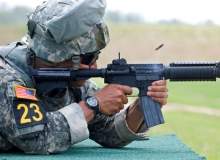

The SIPRI Top 100 report shows the global arms industry, excluding China, was worth US$395 billion in 2012, compared with $412 billion in 2011. It is the second consecutive annual fall in sales for the top 100 companies.
The top ten defence companies remained largely unchanged with Lockheed Martin, Boeing and BAE Systems leading the pack, while United Technologies – owner of Sikorsky and Pratt & Whitney – moved up two places to take the position of eighth biggest defence company.
Increasing arms sales in Russia
Overall, sales for companies in the United States, Canada and Western Europe are decreasing while Russian companies have seen sales ‘increase sharply’, 28% in real terms. Russian defence giant Almaz-Antey – makers of air defence systems – saw a 41% increase in sales in 2012 and is now ranked 14, the highest position for a Russian company since 2002.
The increase in sales for Russian companies reflects large and growing domestic sales as part of Russia’s US$700 billion State Armaments Plan, the report says.
"The Russian arms industry is gradually re-emerging from the ruins of the Soviet industry", said Dr Sam Perlo-Freeman, Director of SIPRI’s Military Expenditure and Arms Production Programme.
"Nonetheless, the industry is still plagued by outdated equipment, inefficient organization and widespread corruption, which will continue to limit Russia’s ability to compete technologically with the West," he added.
The share of sales for companies outside of North America and Europe has been increasing since 2005 and is now at its highest point in the history of SIPRI’s Top 100. Despite this, companies headquartered in North America and Europe continue to ‘dominate’ the global arms industry: 73 companies out of 100.
UK Ministry of Defence Rear Admiral Chris Parry identifies some of the major drivers of conflict to 2040.
SIPRI’s Top 100 for 2012 includes companies from 23 countries, which is the highest since the institute began compiling data. It represents a diffusion of global large-scale, corporate arms production, though the dominance of the US and Europe ‘remains largely unchanged’.
Budget cuts in US and Europe
The decline in arms sales in the US and Europe mirrors the decline in defence spending witnessed over recent years. SIPRI highlights the withdrawal from Iraq as having a ‘significant effect’ on US companies, in particular KBR – which provided logistics support to US forces in Iraq – its sales fell 60% in 2012 and was the largest decline on the list.
"The US arms industry has fallen back somewhat from the heights it reached before the
Budget Control Act, when the USA was still embroiled in two wars. But it still enjoys sales and profits that are very high by historic standards," said Perlo-Freeman.
The report also highlights the growing sales from arms manufacturers in emerging markets like Brazil and Ukraine. Brazilian manufacturer Embraer was one of the largest risers in 2012 with 36% growth and the newly-formed Ukranian holding company Ukroboronprom entered the list for the first time.
On the whole, the report offers no real surprises as US and European companies continue to dominate the arms industry. Despite their surging growth in sales the leading Russian company, Almaz-Antey, still makes around seven times less than the top company, Lockheed Martin.
No doubt the main worry for the largest arms companies will be the ongoing defence cuts across Europe and the US. With no sign that defence spending will increase anytime soon, the falling sales trend that has been identified in SIPRI’s 2012 report will likely be repeated again next year.
Follow Grant Turnbull on Google+


.gif)

